[Editor’s note: This document was written during the spring semester of 2014 by students and faculty at Swarthmore College in the course “PEAC 077 Gun Violence Prevention” with help from students and faculty in “POLS 071 Applied Analysis with GIS.” The document is not updated to account for changing trends in gun violence.]
The National Crime Victimization Survey reports that 467,321 people were the victim of a crime involving a gun in 2011, and the Bureau of Justice Statistics reports that 23% of victims of nonfatal firearm crime, roughly 100,000 people, became injured. Preliminary analyses of 2011 data estimates more than 11,000 firearm homicides in 2011.
While the number of gun related homicides in the U.S. has been steadily declining over the last quarter century, the national firearm homicide rate is still 20 times higher than the combined rates of 22 countries that are our peers in wealth and population. Everyone is not at equal risk however. In 2010, 84 percent of gun homicide victims were male, and seven-in-ten were between the ages of 18-40. Likewise, gun homicides break down disproportionately by race as well; black people account for more than half the victims despite accounting for less than 13 percent of the total population.
Delaware County
Delaware County, population of 561,973, is a suburban county that lies southwest of Philadelphia. Even though it has one of the highest median household income rates and lowest percentage of people below the poverty line in the state of Pennsylvania, between 2005-2013, there were 312 homicide victims in the county. Similar to the national age trends, the median age group of gun-related homicides for Delaware County 2005-2013 is about 19-25 years old. While only approximately 21 percent of the county’s population is African American, this group accounts for more than 75 percent of the homicides in the county between 2005-2013.
The Delaware County Homicides Map reveals homicide clusters in the eastern region of the county and the city of Chester. These are the same areas of the County with high percentages of non-white residents and low median incomes. The DCH Map therefore provides layers related to race and socio-economic demographics that can be toggled on and off by users.
Homicides in Delaware County
Figure 1. shows that Delaware County as a whole has a homicide rate similar to the national average and considerably lower than its neighbor to the east, the City of Philadelphia.
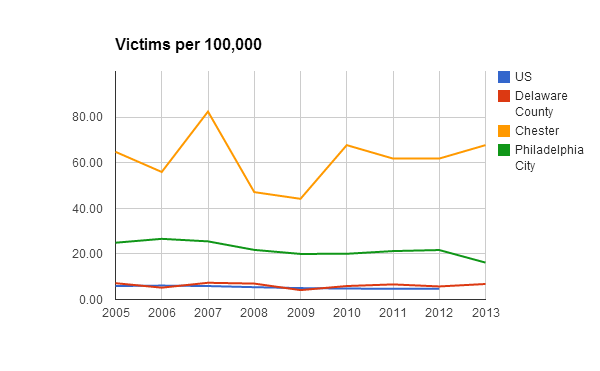
However, Chester, the only city located in Delaware County, has a significantly higher homicide rate. This seeming inconsistency is resolved by the fact that Chester’s population contains a larger proportion of people who fall in high-risk categories for homicide, namely young black males, than either Philadelphia, the nation or the county as a whole. Figures 4, 5, & 6 provide further information on the breakdown of homicides by age, race, and gender.
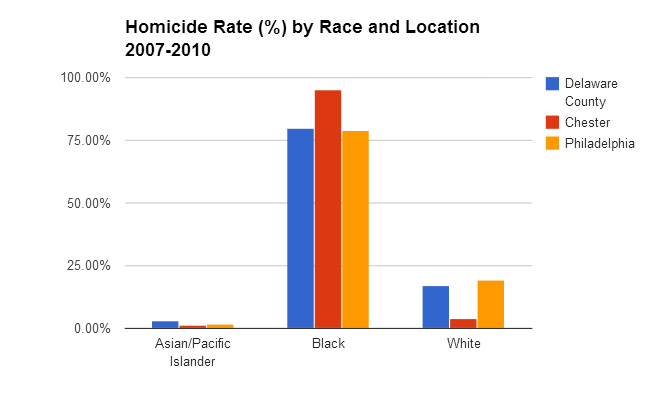
As Figure 2 demonstrates, homicide disproportionately affects black people–a fact consistent across Delaware County as a whole, Chester, and neighboring Philadelphia. While the percentage of black homicide victims in Philadelphia and Delaware County are roughly the same, the percentage in Chester is even higher. This is likely due to the fact that Chester has a higher percentage of black residents than the much larger City of Philadelphia.
Gun Violence in Delaware County
Young people experience gun violence disproportionately in the United States. Those in the 20-24 age range are most likely to become victims of gun homicide. During the peak years in the middle 1990s, their rates rose above twenty percent, but even as rates overall declined, they remained the most vulnerable class of victims with rates holding steady between ten and fifteen percent. (Firearm & Injury Center at Penn 2011, pp. 19-20).
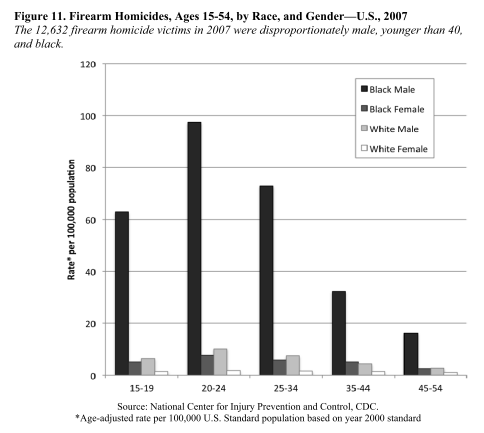
Firearm Homicides, Ages 15-54, by Race and Gender–U.S., 2007
Reprinted with permission of the Firearm & Injury Center at the University of Pennsylvania. Figure 11 (Firearm & Injury Center at Penn 2011, p. 19)
The Gun Violence Database for Delaware County reveals that, in 2007, most victims were between the ages of fifteen and forty-four, though unlike the national averages, those age twenty-five to thirty four were at the greatest risk. (Figures 4 and 5 below represents age-specific gun homicides in Delaware County and Chester in 2007 to compare with the same year of national data presented in Figure 3. However, readers should note that the national rates in Figure 3 are age-adjusted. Thus, the results of Figures 3, 4, and 5 cannot be compared directly, but the shapes of their distributions reveal different trends).
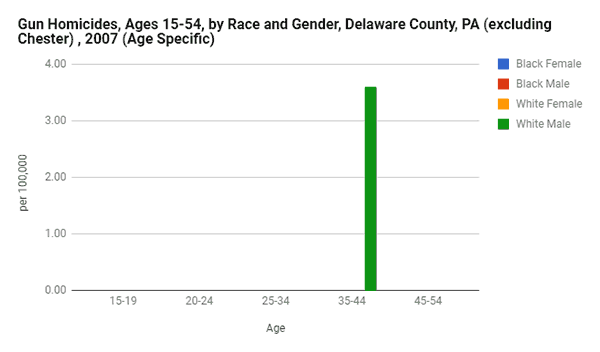
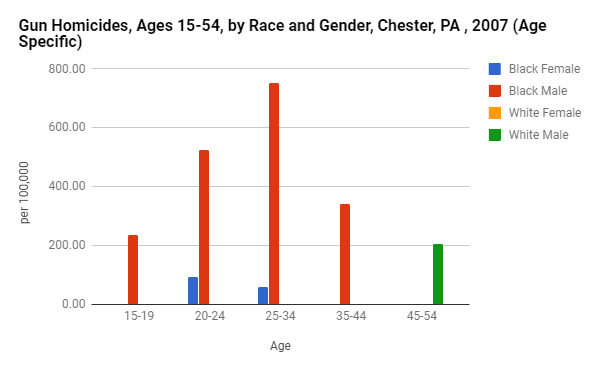
Chester, in particular, exhibits very high rates of gun homicide that victimize young black males. These rates rival national rates by race, age, and gender, but the highest risk group in Chester is actually the 25-34 age bracket compared with the 20-24 age bracket nationally.
This data reveals that, compared with national trends, the average young black male is at an especially high risk of becoming a victim of gun homicide if he lives in Chester. His risk is much higher than those in any other demographic group. Moreover, the homicide rate for black males aged 25-34 in Chester is more than four times higher than that of Delaware County as a whole because it contains a higher density of high-risk individuals.
Mapping Homicide in Delaware County
The clustering of homicides is fairly clear to the naked eye in the maps below (e.g. see Figure 6), but as one can see, several variables, including income, population density, and race, appear to correlate with homicide rates. Note that when homicides are measured in rates per 100,000, one year of data (2010) has been isolated and represented in the maps.
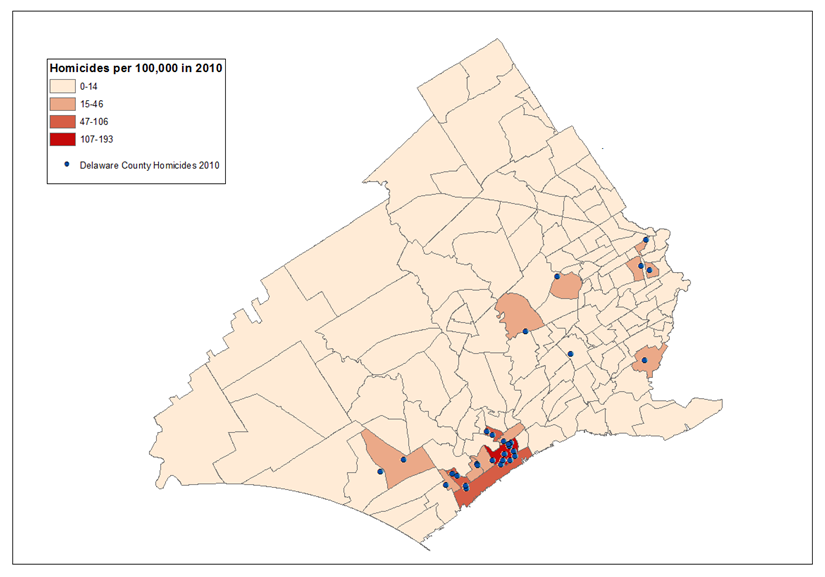
Geographic distribution of homicide incidents and homicide rates by census tract.
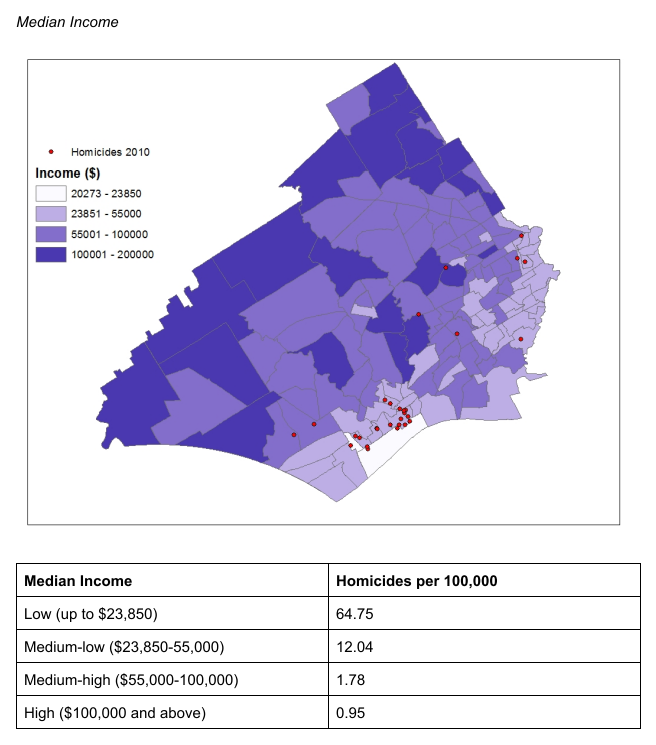
One’s income is strongly correlated with gun violence rates (See table above). This correlation in 2010 is particularly evident in the lowest income bracket, with the homicide rate for those earning under $23,850 more than 5 times higher than those earning between $23,850-$55,000 and nearly 65 times higher than those in the top income bracket. As $23,850 is the poverty line for a four-person household, it is clear that people living beneath the poverty line are disproportionately victimized by gun homicides. This means that individuals living beneath the poverty line are at 8 times greater risk of being murdered with a gun than the Delaware County average. Conversely, the risk of gun violence for those earning $100,000 and above are approximately 8 times lower than the Delaware County average.
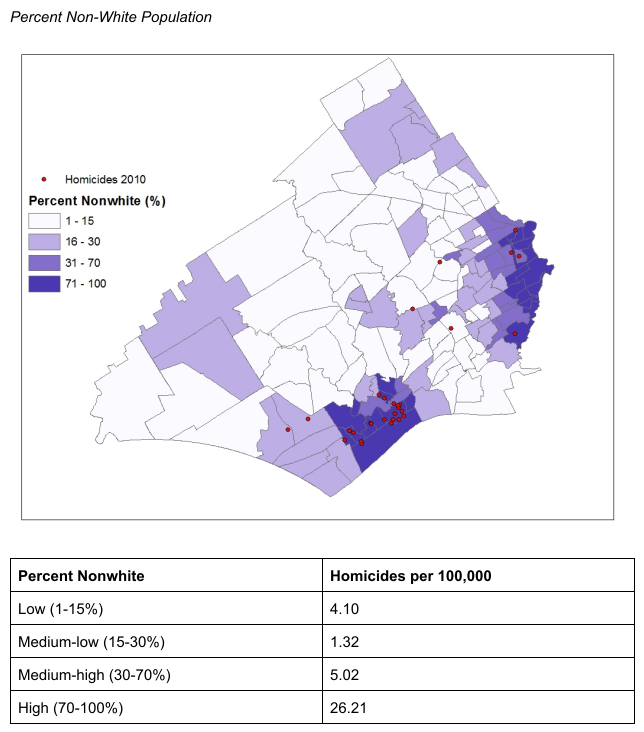
As we would expect from the research literature on gun violence, it appears that people of color in Delaware County are at most risk of gun homicide. Tracts with low nonwhite populations had a homicide rate of only 8.45 per 100,000, compared to 232.96 in high nonwhite population tracts.
All three environmental variables we examined (low income, high percentage nonwhite population, and high population density) are elevated around Chester and in eastern Delaware County, closer to Philadelphia. Homicide rates are dramatically higher in and around Chester than anywhere else in the county.
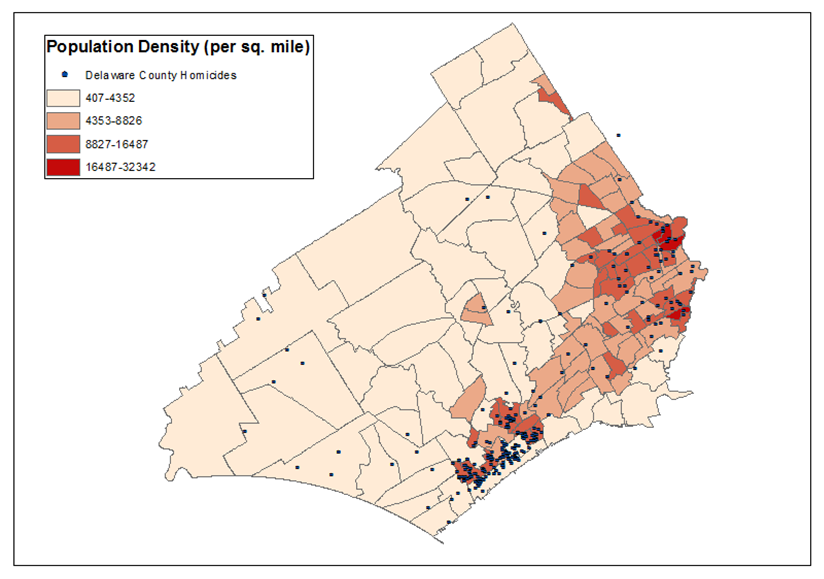
Our findings suggest that race and income are more correlated with homicide rates than population density. Homicides seem to happen most consistently in census tracts with population densities over 8,827 people per square mile, but there is a conspicuous number of homicides southeast of interstate 95 in Chester. We should also remember that higher population density does not necessarily constitute a social problem that exacerbates rates of homicide but may simply represent a concentration of the usual social circumstances and relationships in which homicides occurring.
Guns and Homicide in Delaware County

Figure 10 reveals that the use of a gun in Delaware County homicides is greatest among the already high-risk age brackets: 18-24 and 25-34. This is not surprising as we know that, nationally speaking, young men are at highest risk to be victimized by gun violence. By contrast, young children and the elderly are more likely to become victims of abuse and negligence than gun violence.
Guns and Homicide in Chester
Chester is the only city located in Delaware County and is known to be the location at which William Penn first landed in 1682. Residing along the Delaware River, Chester was once a major industrial hub, although most major industry has since left.
Our research has led us to have a special concern for Chester and its citizens. With a population of only 30,000 people, Chester has one of the highest rates of violent crime per capita of any city in the nation. It therefore comes as little surprise that Chester is the locus for the largest cluster of homicides on the map, accounting for over 60 percent of all homicides in Delaware County. With approximately 65 homicide victims per 100,000 people, Chester has a homicide rate nearly three times higher than neighboring Philadelphia (a much larger and more diverse area) and 10 times higher than the national average (see Figure 1).

However, it would be a mistake to characterize Chester only by its homicide rates. If the population of Chester in 2012 (34,031 people) were represented by these 100 figures, less than one person (.062, approximated in red in the figure above) would have been a victim of homicide. Life in this small city is much more complex and rich than the city’s homicide rate. Thousands of children safely attend Chester’s nine schools, even more gather in one of Chester’s nearly 200 churches. Despite the higher rates of violence in Chester, more than $1.5 billion dollars in private and public funds have been invested in the city over the last 18 years.
We hope that a greater awareness of gun homicide in Delaware County and Chester will inspire new policy initiatives and grassroots mobilization aimed at reducing gun violence while informing debate and problem-solving efforts.
This page was written by students and faculty in PEAC 077 Gun Violence Prevention and POLS 071 Applied Analysis with GIS.